There is a Russian idiom “The Hamburg Score”. It comes from a legend saying that professional wrestlers of the world gathered in Hamburg once per year at the beginning of XX century to find out who is the best. The point is that they did it for themselves, not for public.
This story came into my mind at bpmNEXT conference because of its unique atmosphere: no marketing stuff, no lead generation, no speculations about what BPM is – nothing of what one may expect at a typical BPM event. Just a professional showcase of tomorrow’s BPM.
As Bruce Silver (one of conference “fathers”, together with Nathaniel Palmer) said in the introductory speech, the most interesting moment of a BPM conference is when someone opens the laptop during a coffee break and says: “look at the cool stuff we’ve released to beta last week.” So we decided – Bruce continued – to throw away everything else and keep just this.
The plan was risky: why would BPM vendors share their latest ideas and achievements not even with public – with competitors?! Yet it worked, and worked great! BPM & Mobile, BPM & Social, BPM & ACM, BPM & things you weren’t even aware of – one could get it all in live demos followed by honest Q&A’s and backroom discussions.
bpmNEXT is supposed to become an annual event with fixed venue in Asilomar at the Pacific coast near Monterey, CA. To make the analogy of the “Asilomar Score” complete, the bpmNEXT’2013 ended by “Best on Show” voting – just like wrestlers, BPM-ers decided who’s the best at the moment.
The course
Bruce Silver’s foreword was followed by the key presentation by Paul Harmon (BPTrends.com), probably the most influential practitioner and analyst in the industry.
Paul Harmon raised the question that resonated in all participants: where BPM currently is in terms of the Technology Lifecycle, did it pass the Moore’s Chasm?
By Paul’s observation, there is a considerable growth of interest to BPM in the corporate world since the 2011 fall. It’s pretty close to what we observe here in Russia – a strong raise of interest towards BPM since the end of 2011.
However BPM is still at the Early Adopters phase and didn’t cross the chasm yet. In simple words, it means that BPM today is safe enough for potential users but companies don’t consider it as a must-have like e.g. ERP. Paul predicted that BPM will cross the Chasm in next couple of years but didn’t argue it well I’m afraid. He wished to have two or three really great BPM success stories like e.g. a straight-through supply chain implemented in BPM – it’d help to break the barrier.
Then Paul raised another question: what are the major stoppers? He shared his observation that there is a chasm at a single organization level: many organizations fail to progress from managing single processes to systematic control over processes enterprise-wide (from level 2 to level 3 on the BPM maturity scale). The possible reason is lack of BPM adoption at senior management level – it’s not on the agenda of most decision makers.
During the discussion that followed we tried to unwind the causes-and-effects chain. The immediate cause – BPM is not a first-class citizen at business education. This raises another question: is BPM magic or science? Paul answered that it’s a science indeed because he personally is able to produce sustainable results. But with all my respect, it can be an indication of magic as well. If it was science, a range of practitioners with adequate education would be able to achieve the results or improve results achieved before him/her. Did we reach such interchangeability of BPM practitioners? I seriously doubt.
The moment of truth is when a prospective customer says: “OK, it was very interesting. Now where can I read about it?” As Denis Gagne pointed out in a private conversation, each of us can recommend several books but all of them would teach BPM differently. Again, if it was science, we could say: “Look, here are three books – pick any of them, they are basically the same.” Unfortunately we aren’t there yet.
BPM is still a very interesting matter for those involved and this is the problem. It should be dull and boring to become a mainstream!
May be we are too impatient? Because BPM adoption speed doesn’t match our expectations we add more features and component or even redefine it by naming “i-Something” starting from today. It’s like adding more bells and whistles in attempt to attract public to circus. At no surprise, BPM is not just too complicated – even worse, it’s a moving target.
The only way to deal with this problem that I can imagine is to develop and actively promote a Body of Knowledge covering a core set of BPM methods and technologies. Something not too broad, not too advanced, not revised too often (hence better printed than wiki). Nothing close to a bleeding edge, definitely. This is the way to send prospective customers a message that BPM is mature, safe and predictable. And this is basically what ABPMP does, I believe.
Well, I’ve got too far from Paul Harmon’s presentation. Getting back to the conference, the first day comprised Bruce Silver’s foreword, Paul Harmon’s key presentation followed by Q&A session and discussion that continued at the dinner.
The best from the best
The remaining two days (March 20 and 21, 2013) were tightly packed with 24 presentations and live demos. It’d be OK if some of them could be ignored as it happens at most conferences. But not this time. Not all presentations were equally valuable for me personally but all were very interesting.
The following is by no means a full coverage, it’s rather a collection of teasers or bookmarks for further reading. The selection is personal – the best from the best from personal point of view. All presentations and video are promised to be available at bpmnext.com so you’ll be able to get your own opinion.
“Process Mining” by Anne Rozinat and Christian Gunther, Fluxicon. An elegant tool presented in elegant manner – not a surprise they won “Best on Show”. The process mining is basically this: 1) Take a ERP event log as input. It must have a case id, performer and task names, task start and end timestamps. 2) Load it into the tool. 3) Enjoy intelligent graphs of process routes, delays, re-do’s and runaway cases. This is a good answer to managers saying “all our processes are implemented in the ERP.” With all dirty secrets revealed by the tool it turns out that they have very rough idea about “as-really-is” processes (not to be confused with “as-is”). The only thing that makes me skeptical about process mining – it may be perceived as a nice addition to ERP rather as a driver to full-scale BPM effort.
“Managing Process Roles and Relationships” by Roy Altman, PeopleServ. A typical BPMS-based BPM project consists of four parts: process models, data models, UI, organization structure. And the last part isn’t the least in terms of costs – it may take as much as 1/3 of total project man-hours. The major problem here is lack of standardization – there is no single truth about organization hierarchy, reporting relations, positions and roles. Roy presented a nice tool aimed on this.
“Data-centric BPM” by John Reynolds, IBM. I blogged about “process-data marriage” and issues with the approach utilized by some BPMS vendors so I was pleased to see what IBM is working on. They introduced data-level business rules: it’s possible e.g. to declare that certain process attribute is visible only to certain users and another set of users is able to edit it. This logic is then applied to all web forms at the UI level. I believe it’s a good idea because currently this part of business logic is distributed across the UI.
“Social and Mobile Computing for BPM and Case Management” by Rhonda Gray, OpenText. OpenText is famous for dozens of acquisitions, including Global 360, Metastorm. A number of products on hands resulted in the idea of creating a unified user interface available on any device, including mobiles indeed. And this is what they did. The product named “Touch” also features nice social functions like being able to subscribe to certain case or person much like we do in Facebook or Twitter. Rhonda’s presentation was my personal “Best on Show” choice because unified task management is my biggest dream. Every now and then prospective BPMS users say: “What, another portal?” And this is valid concern because they already have ERP, CRM and other off-the-shelf apps each with its own portal and now come BPMS, ACM, ECM and who knows what else… All these tools implement some kind of a personal tasks list but each in its own peculiar way. So the idea of a unified “personal to-do list” is obvious; however it isn’t implemented so far. The popularity of social functionality gives this idea another chance and OpenText comes close to make it reality. I only wish they widened the scope from integrating they own products to developing an open standard/protocol/tool able e.g. to get tasks from ERP and CRM suites.
“Model-Driven Generation of Social BPM Applications” by Emanuele Molteni, Webratio. Webratio develops and promotes WebML – a XML markup language for web applications design. Strictly speaking, it’s not about BPM, BPM is just one possible applications. Anyway the approach is interesting and the interest doubled with the news that it’s on the way to standardization within OMG by the name IFML (Interaction Flow Modeling Language). Will keep an eye on this.
“Social Process in the Cloud with Facebook” by Joel Garcia, TidalWave. The mind-breaking presentation. The old school programmers wrote code that only used OS system calls. High-level languages were based on utility libraries, ending in Java and .NET frameworks. Then internet browsers become a kind of OS for web applications. And now Facebook becomes an operating environment! Joel showed how a BPM application is deployed for production as a Facebook application.
“Goals in the Process Continuum” by Dominic Greenwood, Whitestein. The second winner of the “Best on Show” contest. Whitestein was a kind of a “dark horse” – they were mentioned in the unfamous Gartner’s iBPMS MQ but little else was known. Now I know that they do have innovative things – Whitestein has developed a notation to depict a hierarchy of process goals that adds another dimension to process modeling. In fact, it’s not just for processes – it can be utilized for case management, too.
“Performing Collection of Activities as Mans to Business Ends” by Denis Gagne, Trisotech. A vague title yet very clear content. Trisotech is the company behind the Business Process Incubator project. I perceived it as a (yet another) BPMN modeler but it turned out to be much more. Firstly, Denis has demonstrated an impressive web tool for gathering process information during initial analysis phase. Secondly, thanks to him I became aware that there is CMMN (Case Management Modeling Notation) draft already published by OMG – the tool supports this notation as well as BPMN.
“Antifragile Systems for Innovation and Learning Organization” by Keith Swenson, Fujitsu. The third “Best on Show” winner. The presentation started with a philosophical part: what antifragility is and how it differs from robustness (robustness means remaining the same despite external impacts, antifragility relates to “if it doesn’t kill you, it makes you stronger”). It was entertaining, but the cool part was what followed – the live demonstration of the ACM tool. Although it’s in beta, it looked quite polished. The only thing I missed was the ability to transform a task not only to a sub-case (this is what Keith demonstrated) but also to a strictly-defined process. I’m convinced that there should be unified BPM+ACM tool, not two separate ones, because processes and cases use to call each other and morph into each other.
The wishes
It may seem that the event was too technology-oriented. Technically it was because methodological aspects of BPM were discussed very briefly except in Paul Harmon’s presentation. But it was predefined by the format – the whole event was about the newest and coolest tools. Yet I didn’t feel disappointed as it happens too often at typical BPM conference when someone pushes “BPMS without BPM” approach. Not this time because all presenters were knowledgeable in methodology, too.
One could get an impression from my coverage that BPMN wasn’t presented. Wrong: probably half of presentations either focused on BPMN or mentioned it. But BPMN isn’t cool any more, it goes without questions. Which is good: as I mentioned above, BPM needs more boring things to become mainstream.
All modern BPM technology trends were presented: mobile, social, ACM, clouds. Mobile and cloud are the most mature; they can be positioned as “NEXT” this year, but probably not at bpmNEXT’2014. Social and ACM are slightly behind, there are still challenging.
I was glad to see the efforts towards integrated process and data modeling. As for unified task management and holistic organization modeling, they are at experimental stage.
The only trendy topic totally missing was gamification. Could be a nice addition to social functionality. May be next year.
Another - more important - social dimension of the event was a unique opportunities to “attach faces to names”. Most participants knew each other for years as fellow bloggers and it was great to shake hands and to have “a glass of coffee” together.
Once again, thanks to all who came for awesome company and sorry to those who couldn’t.
Update
I intentionally wrote this post before reading anyone’s else. Now here they are:
- Sandy Kemsley posted a series of articles
- Thoughtful posts from Scott Francis: one, two and more
- Paul Harmon
- Bruce Silver
- Neil Ward-Dutton



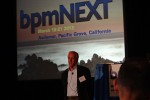

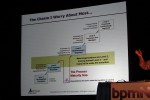



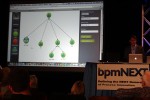
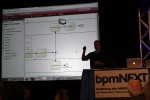

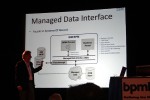
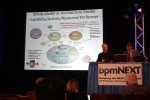
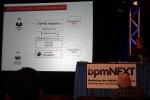
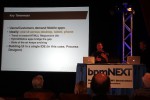
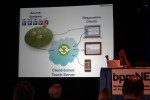




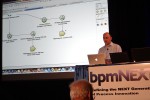










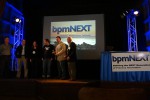
btw loved this part:
“During the discussion that followed we tried to unwind the causes-and-effects chain. The immediate cause – BPM is not a first-class citizen at business education. This raises another question: is BPM magic or science? Paul answered that it’s a science indeed because he personally is able to produce sustainable results. But with all my respect, it can be an indication of magic as well. If it was science, a range of practitioners with adequate education would be able to achieve the results or improve results achieved before him/her. Did we reach such interchangeability of BPM practitioners? I seriously doubt.”
I refer to it as neither science nor magic, but inbetween - a craft. Like many crafts, the best way to learn is from a current master craftsman. But depending which craftsperson you learn from, you will pick up a different style, angle, approach. In our day and age of sharing, you are likely to incorporate other ideas- some from Bruce, some from Denis, some from six sigma, some from ACM, etc. But solving the problems we solve is still more like a craft - requiring significant judgment as well as execution. When I do math, I don’t have to think about the right way to solve a math problem, i just do it (until we get to the area of proofs). So BPM has a way to go to become either a science or engineering discipline. And it may appear to be magic to those who don’t quite understand it yet - but I think it is more likely a craft…
My 2 cents!
and maybe next year we’ll have something to show that you’ll be interested in never know!
never know!
Scott, craft is the exact word! Sorry for not covering your presentation.
Hi Anatoly,
Great blog, and great post.
I’m interested in BPM for small-mid sized businesses. The tie to ERP is telling — BPM seems too expensive for anyone but large companies. The few consultants I’ve spoken with have left me with the impression that I’d be spending large amounts of money (relative to my budget) to accomplish relatively small things. If I were a large company and that small thing was worth millions, then spending hundreds of thousands of dollars to optimize it would make sense. But for my company, it doesn’t.
I guess I assume that the adoption will proceed first in large organizations, as they use BPM to bolster or replace some ERP functions. Then, as the design patterns and actual process best practices get sorted, then shrink-wrapped versions may become available for smaller organizations.
An area I think is interesting is process classification, e.g. APQC’s process classification. If you align standardized BPM implementations with standardized process lists, you have a way to commoditize the product, enabling dramatically lower costs, interchangeability, and applicability.
The whole process of commoditization involves refactoring products down to a set of features that define a market of interchangeable products. I could imagine that process classification might provide a blueprint for refactoring business processes, allowing BPM suites to be written which offer them “out of the box.” One effect of commoditization is that clients trade customizability for efficiency. I think the mid market would appreciate BPM provided and enabled efficiency, if the expense of conforming existing in-house processes to the standard process is low enough. Can that intersection exist? I think so.
Of course, these are just opinions, and I’m sure others who have had different experiences & different perspectives may think differently. I’m open to hearing the opinions of others
Edward
We implemented a very successful project for a company of 35 people. Successful in terms of customer’s KPI of course: the cycle time of RFP processing, percentage of errors in quotations etc. Subscription to Bizagi BPM Suite Xpress costs 40 euros per user per year and the quality of the product is what one may expect from enterprise-grade software.
The biggest cost isn’t the software neither external consultants’ man-hours - it’s the internal resource capable to analyze processes. Typically a company of less than say 200 employee cannot afford a business analyst. The company I refer couldn’t either but they have smart managers on the top who could do the job themselves and it saved the whole game.
Large companies have other issues that aren’t easier. Typically there is no one on the top willing to participate in process work. They expect that people behind will do the job. And they will on department level but enterprise-wide end-to-end processes obviously need top management involvment.
I don’t buy the APQC framework. The APQC and PWC models are essentialy functional, not process-oriented. As an example, since they put delivery and payment in different branches of the process hierarchy, the “order to cash” process falls out of scope. We use Rummler’s value chain as a top-level framework.
And I don’t believe in shrink-wrapped processes as long as we are talking about core value-creating processes - they are always unique.
Loved your post Anatoly,every bit of it, thank you!
I will try to join you next year.
Hi Anatoly,
Enjoyed reading your blog about the conference. Hope to make it next year.
I would like to comment to what you wrote about Process Mining: “The only thing that makes me skeptical about process mining – it may be perceived as a nice addition to ERP rather as a driver to full-scale BPM effort.”
The technology can be used not only for ERP, but even for BPM solutions. There are already some BPM solutions which support it. All you need is log data, and workflow engines usually create them. I did some projects with Disco for ERP users, and it was easy for the specific ERP (Priority of Eshbel). The main issue is extracting log data from systems that create them. Another issue was convincing managers of the added value. It’s the same one with any other BPM-related solution. But once I started to offer Disco in BI context (i.e., QlikView solutions), it makes much more sense and the reaction are good. I have based my solutions on a nice free book called “Process Intelligence for Dummies”. (Can be downloaded from Software AG website).
I would like to disclose that none of the above vendors pays me anything.
Anatoly,
Thank you for your thoughtful response. You have me very interested in Rummler now. Do you have any book suggestions? I’m googling for Rummler and reading what I can, I see that his primary contributions seem to be some years ago so I wonder if you think any of his successors might be better for someone just learning, like me?
If I’m reading your response correctly, it sounds as though you think BPM is most valuable for processes that are likely to be unique in an organization. My thinking here is obviously very immature, but I’m a little confused by the common BPM examples of employee on-boarding, invoice processing, purchase processing, hiring, etc. It’s as if there are those who don’t think the way you do and instead seek to apply BPM to processes that are likely to be very similar across organizations. Obviously (I hope) that’s the category of work that I think has the potential for being standardized and commoditized and delivered to SMEs, as they really should not have to be reinvented with every new business.
But to your point that the unique processes are where the gold lies, so to speak, I see your point in the abstract, I think I need to think harder about examples within my own business in order to internalize it.
Again, thank you for your reply.
Dafna
It’s very interesting, thank you, especially the Disco+QlickView combination. Can’t imagine how do you join them.
As for process mining + BPM, the BPM suites I’ve seen all have embedded BAM functionality which is superior to what mining can produce even in theory, because BAM maps process statistics to the real process model while mining do it towards imaginary process.
Edward
I’ve read two Rummler’s books: “Serious Performance Consulting” and “White Spaces Revisited”. Both influenced me a lot. But these readings aren’t easy. Rummler is the man whom today’s process gurus call the teacher. I believe many of his ideas are still relevant and not fully implemented.
Regarding common vs. specific processes, there are basically two categories of processes: 1) those that are the top value for us so we are eager to make them better than any competitor has - there may be 5 to 10 end-to-end processes falling into this category and 2) the remaining ones that we want to be only good enough. Category 1 is better to implement as a custom process solution with the help of BPMS and BPM methodology, category 2 is better to implement within a off-the-shelf packaged application with minimal customization.
You are right, the common examples are simple workflows from category 2. This is because processes from category 1 are complex, industry- and company- specific and usually classified as a company’s top secret. So there is basically no other option for a demonstrator than use category 2 processes. We use a process named “Car Reservation” for demonstration purposes which is fairly abstract and has no business value. So what? This shouldn’t confuse you.
Look here if you want to get the idea of what BPM is really for: http://www.bpmf.org/awards_ceremony_2012.htm Let me know if you found something standard there.
Anyway it’s a paradox, thank you for raising the question. It deserves a separate post and may be I’ll write it some day.
Hi Anatoly,
Re Process Mining functionality (in addition to BAM) in BPM suits - you can check Fujitsu’s Interstage, Process Intelligence by SoftWareAG, XM Pro of iBoss.
As of combining QlikView & Disco - you are welcome to contact me by mail, for further info
Excellent summary! It was great to meet you there, and hope to do so again next year if at all possible. Perhaps I will be seeing you do a talk on the proper application of gamification to make processes and ACM work well.!
My notes on the talk are at: http://social-biz.org/2013/04/14/bpmnext-notes/
-Keith Swenson
Thank you, Keith. Do a talk? It won’t work at this event I’m afraid: words are cheap, show me the product! But I’d love to be there, as most if not all 2013 participants do.
Существуют ли сейчас готовые ИТ-продукты, в которых реализовано BPM+ACM “в одном флаконе”?
типа:
а) шел-шел экземпляр стандарного бизнес-процесса - случилось что-то из ряда вон выходящее - экземпляр БП превратился в кейс
или
б) прошел один.. второй.. третий сходные кейсы и на их основе создан новый стандартный БП
(Ваша цитат: “…процессы и кейсы имеют обыкновение вызывать друг друга и трансформироваться друг в друга…” (С))
Хвастаются многие, но что там за хвастовством - разобраться нелегко. Вражеские шпионы коварно крадутся, наши разведчики умело маскируются